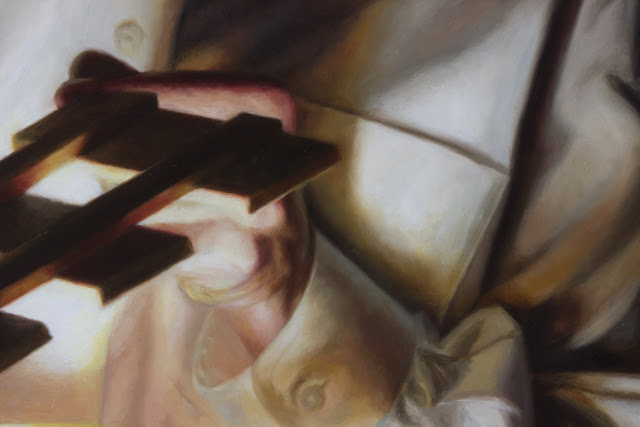Photographing oil paintings has always been tricky and I've struggled for years to get satisfying results. Problems in the past included uneven lighting, fuzzy details, and glare.This new set up gives the best images I've ever had so I thought I'd share.
I have four light stands each with a 33" white translucent umbrella, "premium" light sockets with 65 Watt 5000K UL listed florescent light bulbs. These are "continuous light" not "strobes". It's important that all the bulbs are the same so they all have the same color. Most of my equipment came from CowboyStudio.com. It costs about $100 for two stands, light sockets, bulbs and umbrellas. To photograph smaller paintings two lights may be sufficient.
The lights are arranged at the sides of the paintings rather than in front of them. This "raking" light minimizes glare. To be able to do this the painting is sitting on an easel rather than hanging on a wall. If light pollution from a window is a concern just draw the shades or shoot at night.
My camera is a digital Canon Rebel XTi. After some serious instruction manual reading I set it to Manual Mode, set the custom white balance (by photographing a white poster board under the lights) and set the f stop on 3.5 and Auto Bracket. I use an Ultrasonic 24-85mm lens 1:3.5-4.5. I also use a shutter release cable which prevents camera shake when I take the picture.
I use a tripod, determine the exact middle of the painting from the floor (involves math) and set the tripod so the camera lens is at that height from the floor. Adjust the tilt of the camera angle up and down so there is as little distortion as possible.
Finally I download them to my trusty iMac, perspective crop in Photoshop to crop out my messy studio. There is very little to do in color adjustments. Usually they can be adjusted using levels and channels.
I usually photograph the paintings a second time after varnishing and the results are even better.
I'm sure my photographer friends will see a number of things I could do better and I'm all ears! The process is eternally evolving.
That's easy enough, right?




















